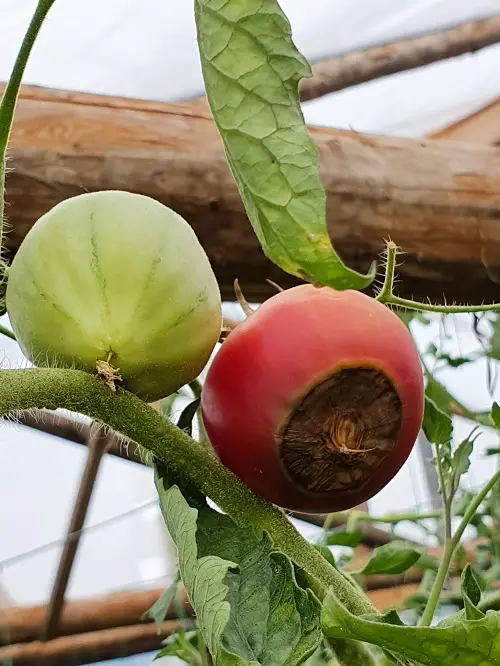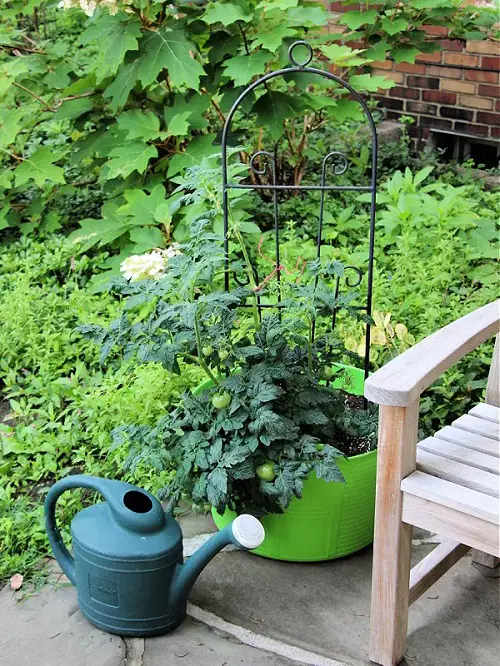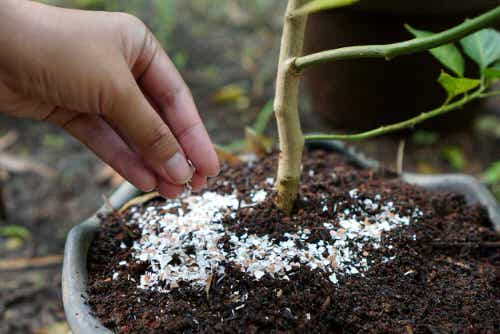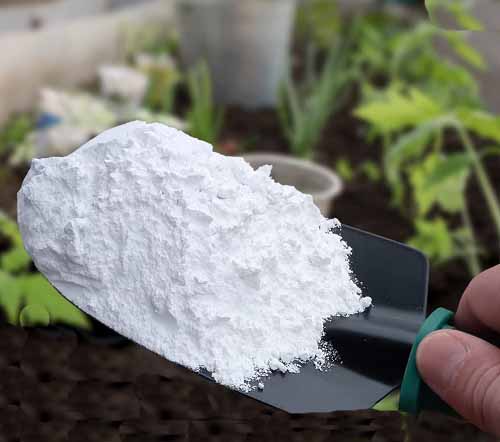Tomato Blossom End Rot taking a shot at your harvest? Here are top tips & tricks to help you eliminate it for good!

Growing tomatoes is fun, but sometimes, these juicy fruits begin decaying from the base, affecting the fruit’s quality and eagerly awaited harvest. Blossom End Rot is a real bummer, but it can be prevented if you know these 7 Easy Home Remedies. Read on!
What is Tomato Blossom End Rot?

Low calcium levels in tomatoes lead to Blossom End Rot. It is a physiological disorder, not a disease caused by pesky visitors like fungi and pests.
Calcium is a building block for healthy tomatoes, especially young ones. Without enough of it transported to the fruit, the lower part begins rotting.
While it doesn’t spread like a disease, if not fixed in time, more fruits start degrading. And in a vicious circle, this condition then interferes with the tomato’s ability to efficiently use calcium. This leads to poor taste and a lousy harvest. Now, how do you spot it?
The rotting starts small. Look for a dark, watery spot on the blossom end of your fruit. If you don’t catch it early, the spot will grow bigger and sink in, turning a nasty leathery brown or black.
How do you prevent Tomato Blossom End Rot? And how do you get rid of it entirely? Well, before we get to that, you must understand this–while the rotting is on the surface of the fruit, the real problem is happening underground. The plant just can’t draw enough calcium from the soil, which leads to decay.
Top Tips to Prevent Tomato Blossom End Rot
1. Water Regularly and Consistently

If you don’t water your tomatoes properly and deeply, they won’t be able to efficiently absorb the calcium present in the soil, even if it is there in good quantity. Fluctuations in moisture levels can make it difficult for the plant to extract and transport this essential nutrient, depleting its calcium levels.
Water is too little, and it cannot take up the nutrients. And if it’s too much, the essential elements get washed away and cause water-logging at the roots, starving them of oxygen.
Here’s the best way to water tomatoes.
- Use drip irrigation or soaker hoses: These water the base of the plant, not the leaves, which helps prevent disease and stress.
- Water in the morning: It allows time for the water to soak in before the heat and reduces evaporation.
- Water deeply and less often: Aim for 1-2 inches of water per week, but check the soil. Water when the topsoil is dry. Deep watering encourages strong roots.
- Mulch around your plants: Mulching helps retain moisture in the soil, so you won’t need to water as often.
2. Banana Peel Supplements

If you’re looking for a natural way to provide your plants with essential nutrients, look no further than your kitchen! Banana peels are a great source of potassium, phosphorus, calcium, and other trace minerals.
Tomatoes need calcium to grow strong, and banana peels have a good amount. While not a miracle cure, this water-based banana peel solution can give it a gentle mineral boost. To make it, simply soak a few chopped peels in water for a day, dilute it with 4 parts water to 1 part of this, and water the base of your tomato plants; keep doing it regularly for good results. Remember, banana peels are low in nitrogen. Supplement this with a regular fertilizer. Here are some great homemade options.
3. Broken Eggshells

Eggshells aren’t a quick fix, but crushing them and adding them to your compost breaks them down over time, slowly adding calcium to the soil. Eggshells don’t quickly heal tomatoes of blossom end rot, though. For better results, you can also make eggshell tea, as suggested here.
While they’re good for your soil, in the long run, the real cause of this disorder is uneven watering. Even with calcium-rich soil, if water flow is inconsistent, your plant may find it difficult to derive the nutrients it needs. While doing this, also fix the infrequent watering!
4. Milk and Water
We all relish milk for its calcium and rich, creamy texture. However, in tomatoes, it can only be effective if diluted and administered correctly. Too much can cause mold, rot, and smell, and too little will make no difference. Here’s what you do.
- Mix it up: Dilute one part of organic milk with four parts of water. Avoid processed milk products.
- Water it in: Pour this solution around the base of your tomato plant and not directly on the leaves. Aim for about ½ cup to 1 cup of this diluted combination per plant.
Apply the diluted milk solution once a week until you see signs of improvement. For more ways to use milk, read this article.
5. Go for Tums or Antacids

Antacids or Tums are also a good source of calcium and, while unconventional, can help combat blossom end rot.
Crush 4-6 tablets and mix them in a gallon of water. Then, you can either water the soil at the base of your plants or directly spray the leaves early morning.
This will help prevent future blossom end rot but won’t heal tomatoes that already have it.
6. Use Bone Meal
Bone meal is a great source of calcium and can help prevent or mitigate blossom end rot in tomato plants. Mix 1-2 tablespoons of bone meal into the soil where you will plant your seedlings.
If your soil is low in calcium, go with a bigger bone meal boost. Mix it directly into the top layer of your garden soil at the beginning or end of the growing season. This will help raise overall calcium levels in your soil for future plantings. And you can use it for any plant!
Bone meal is a slow and steady provider. It won’t give your plants an instant calcium rush. Instead, soil microbes break it down over time, releasing nutrients gradually. This is why it’s best to add bone meal a few weeks before planting for optimal results.
7. Garden or Dolomite Lime

Garden lime (calcium carbonate) and dolomite lime (which contains calcium carbonate and magnesium carbonate) can help boost calcium in the soil and adjust soil pH, both of which are beneficial in preventing blossom end rot in tomatoes.
The amount of lime depends on your current soil pH and how much you need to adjust it. Lime raises the pH of soil. Tomato plants prefer slightly acidic soil, but if it’s too acidic, adding a small amount of lime helps alkalize it.
The product label should recommend how much to use based on your needs. As a rough guideline, apply about 5-10 pounds of lime per 100 square feet of garden area.
Pro Tip: Put a handful of lime in the planting hole before sowing your tomatoes.
Tomato Blossom End Rot Myth Busted
There’s a lot of talk about Epsom salts preventing and even eliminating tomato blossom end rot. Guess what, but it doesn’t work!
Epsom salt won’t prevent blossom end rot simply because it doesn’t contain calcium! It has magnesium, but that’s not helpful in this situation. In fact, too much Epsom salt can make it harder for the tomato plant to absorb calcium, worsening the problem.


